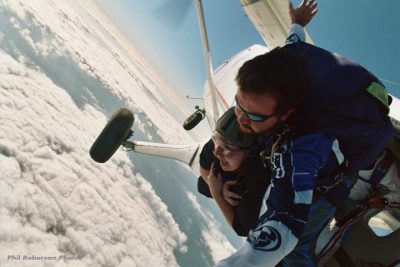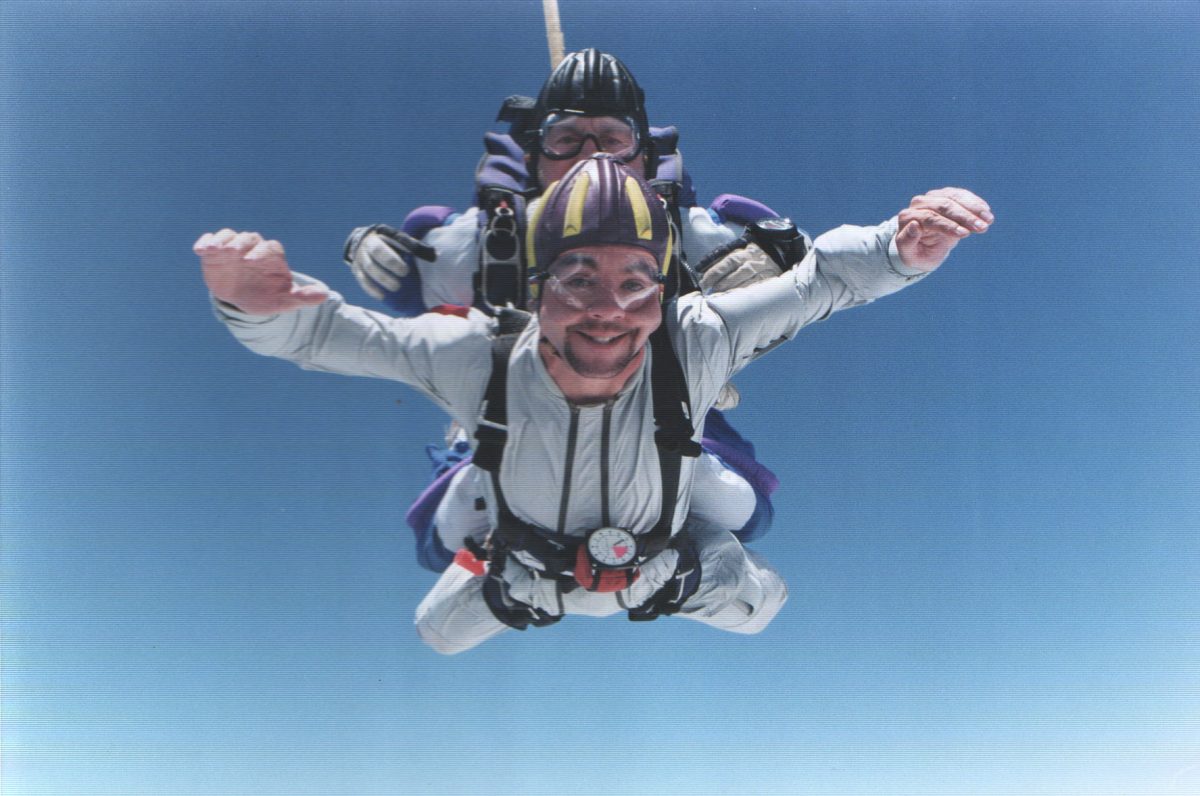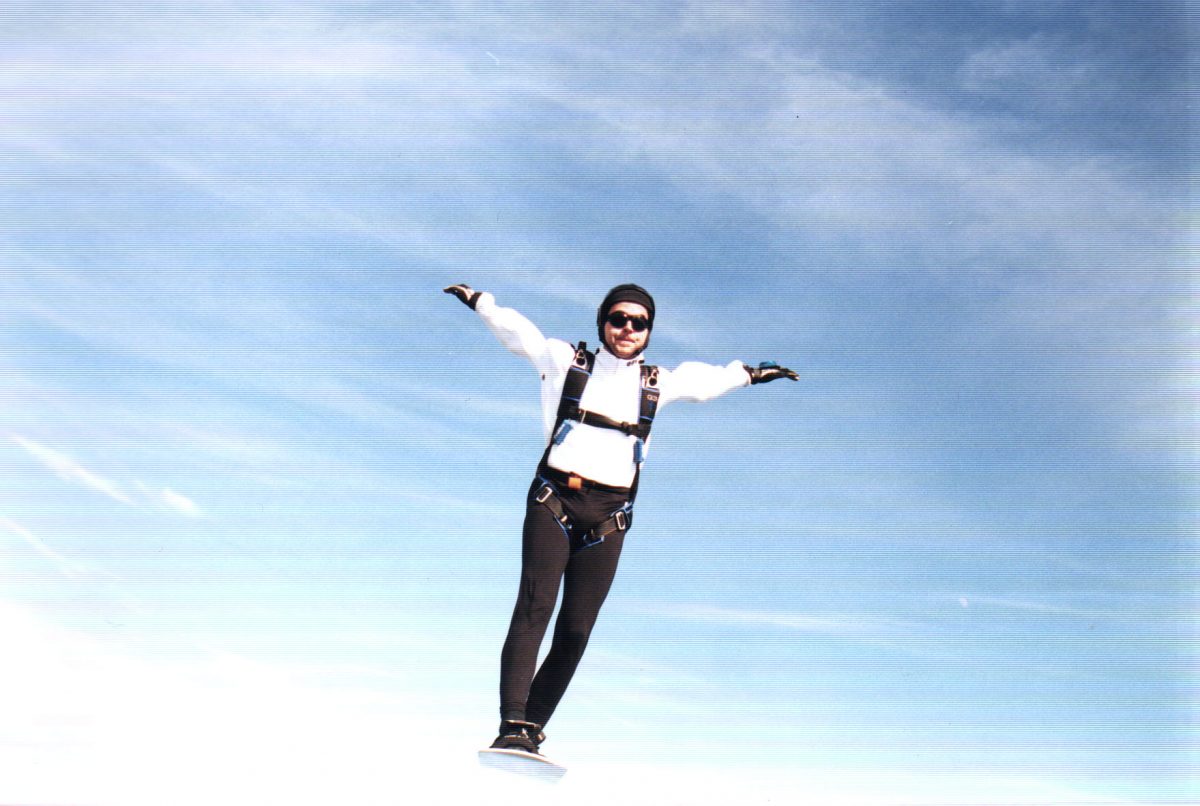
Where Have All The Tandem Instructors Gone?
By Tom Noonan
 When commercial tandem skydiving was first conceived in the 1980s, the idea of a full-time tandem instructor working in the sport was as novel as the very tandem equipment they were using.
When commercial tandem skydiving was first conceived in the 1980s, the idea of a full-time tandem instructor working in the sport was as novel as the very tandem equipment they were using.
At first, tandem jumping was an add-on of sorts, another tool in the tool shed for the dropzone operator. Static line training ruled the day, with the progressive operators at the cutting edge of the sport utilizing the “new” AFF method as the foundation for training new skydivers. At some point during this evolution, dropzone operators began to recognize that the tandem training method, with its condensed training timeframes created a monumental volume increase which generated cash. Lots of cash. As tandem skydiving exploded, the profitability of the discipline was soon appropriated into larger aircraft, and as skydiving became more accessible to the masses as a result of tandem, more first-time skydivers were able to experience skydiving and thus enter the sport.
When Bill Booth and Ted Strong introduced tandem skydiving to the world, they found themselves in a similar situation that the US Air Force found itself in when the decision was made to create a space program. First they needed to create the hardware to get to space. But in doing so, they also needed to create the training programs for the astronauts who would be going into space. Bill & Ted were in a similar situation as they began their “excellent adventure” together, bringing tandem to the world. They created the gear needed to allow 2 skydivers to make a skydive together, effectively putting the “CFI” with the student pilot, mirroring the general aviation pilot training program. The next step was to build their respective training programs and in doing so, they created tandem instructor training programs that would allow experienced skydivers to become tandem instructors. A new rating was then born.
Don’t just send them home with a first jump certificate, send them home daydreaming about their new career with you at your dropzone. Joining your team.
Skydiving Careers
At first, most of the tandem instructor population was born of add-on rating holders. Maybe they held Static Line ratings, maybe they held AFF instructor ratings, and they collectively decided to try this “new thing”, tandem jumping. Shortly thereafter pretty much everyone in the student training process, from DZOs, to instructors, to even packers, realized that this new economy of tandem training, allowed for a full-time skydiving career, that was not only rewarding to the spirit but equally as rewarding to the wallet. Everyone’s wallet, all the way down the line. Thus, the full-time tandem instructor slowly, but surely evolved from this period. As more and more skydivers began entering the tandem world workforce, more and more dropzones were able to take advantage of this new tandem model, and as an industry, we flourished. The supply of tandem students seemed to grow at a constant rate along with the population of tandem instructors, and as a sport, and as an industry, we achieved harmony and equilibrium on the tandem market Supply v Demand curve. It stayed this way for quite a long time, over a decade, as we transitioned from the Point Break 1990s, into the post Point Break leveling off of the 2000s. There was a light at the end of the tunnel in all this so to speak, but no one could see it coming at the time. As a result, no one was able to forecast the effect it would have on our skydiving industry. The light at the end of the tunnel approaching us? That was the Groupon train, and it was headed at high speed for our industry, the effects of which would ripple pro and con, for the next decade. To truly understand the effect it was going to have on our industry, we need to go back to a time, about eight years prior to start. The world had just survived Y2K, and everyone was happy, healthy, and skydiving. Let’s start there then to see where the Groupon train would go on to take us.

Supply v. Demand Disruption
If we go back and look at the population of tandem instructors over the last twenty years, it is fair to say, that the overall volume has remained relatively constant. We have had a population of “X” current/experienced tandem instructors each year, and we  have added “Y” new instructors each year, with “Z” volume of tandem instructors retiring each year at the same time. Y and Z for the most part have canceled themselves out over the years, as we gain new instructors at approximately the same rate that we lose them to retirement +/- a nominal amount. We are then left with a relatively constant, finite population of tandem instructors available year after year to manage the Supply v Demand of the tandem market. This S v D from 2000 to 2010 was relatively constant, and then in late 2008, Groupon and other mass coupon-based web marketing, created a tremendous increase in the supply of tandem customers per annum, without our instructor population increasing at the same rate or any real rate for that matter. The result, on a macro level, (and this is a real-world example, this actually occurred in multiple locations), was that almost overnight, the demand of tandem customers dramatically and immediately exceeded the supply of available tandem instructors to meet the new demand. Let’s call our fictitious dropzone “Skydive Facebook.” They compete in a market with 1-2 or even 3 other large volume DZs in the same market, all relatively successful give or take from 2000 to 2009, with a few more smaller 182-size DZs also maintaining and thriving as viable businesses in these markets, and everyone more or less achieved their annual customer goals. The competitive struggle at the time then so to speak, was who came up first in a local area web search. Everyone was pursuing the same forecasted volume of potential tandem customers each year. And it worked, for everyone in the market. In this Supply v Demand equilibrium model, Skydive Facebook averaged 2000 tandems a season, and were successful. If they were really busy, maybe a new skydiving movie came out, so maybe they did 2500 to 3000 that year, and that just meant that their “10 a day tandem instructors” had to occasionally do 15+ a day to meet this unexpected new short term demand increase, and all was well.
have added “Y” new instructors each year, with “Z” volume of tandem instructors retiring each year at the same time. Y and Z for the most part have canceled themselves out over the years, as we gain new instructors at approximately the same rate that we lose them to retirement +/- a nominal amount. We are then left with a relatively constant, finite population of tandem instructors available year after year to manage the Supply v Demand of the tandem market. This S v D from 2000 to 2010 was relatively constant, and then in late 2008, Groupon and other mass coupon-based web marketing, created a tremendous increase in the supply of tandem customers per annum, without our instructor population increasing at the same rate or any real rate for that matter. The result, on a macro level, (and this is a real-world example, this actually occurred in multiple locations), was that almost overnight, the demand of tandem customers dramatically and immediately exceeded the supply of available tandem instructors to meet the new demand. Let’s call our fictitious dropzone “Skydive Facebook.” They compete in a market with 1-2 or even 3 other large volume DZs in the same market, all relatively successful give or take from 2000 to 2009, with a few more smaller 182-size DZs also maintaining and thriving as viable businesses in these markets, and everyone more or less achieved their annual customer goals. The competitive struggle at the time then so to speak, was who came up first in a local area web search. Everyone was pursuing the same forecasted volume of potential tandem customers each year. And it worked, for everyone in the market. In this Supply v Demand equilibrium model, Skydive Facebook averaged 2000 tandems a season, and were successful. If they were really busy, maybe a new skydiving movie came out, so maybe they did 2500 to 3000 that year, and that just meant that their “10 a day tandem instructors” had to occasionally do 15+ a day to meet this unexpected new short term demand increase, and all was well.
Then… Skydive Facebook enters the Groupon market. And immediately, overnight, it doubled and in many cases tripled it’s customer numbers. They went from 2000 to 6000 annual tandem customers overnight. Wow. Now they need more staff. They have now found 3 years’ worth of work, based on their current model, to get through in a single season. Then to stay in the market, “Skydive Google” down the road, sees this, and does the same thing to remain competitive, and so on. In many markets the demand for the tandem service doubled and/or tripled, without the supply of tandem instructors increasing at the same rate. (Disclaimer, this post is neither pro nor con Groupon, I am only sharing what I saw as a result of it on a macro level). This shift in demand began around 2009/2010 and we managed to navigate it for quite a few years, but it slowly became skydiving’s version of tandem “Jenga”, with each destabilizing stick of the Supply v Demand curve being removed as time went on and supply v demand gap got worse. Eventually, then the whole thing started to wobble over time, with an inevitable crash on the horizon, that someday there would be more tandem customers sold on tandem than existed an adequate supply of tandem instructors to meet that demand.
Burnout
 The other affect that this situation had on the tandem world was it increased the workflow volume demand of the current tandem instructor population. If the instructor population didn’t increase to meet the new demand, then the workflow of the current population had to increase to meet the new demand. And while we have a healthy, vibrant population of tandem instructors that can effectively manage a 15-20 tandem day, Friday, Saturday and Sunday, week after week, month after month all season, there is a growing number of instructors that correctly acknowledge that they can’t sustain that workflow any longer, and are declining work opportunities because it is too taxing on them in the long run physically. It used to be that getting 8-12 tandems was a great day, and if the instructor got 15 tandem jumps, they were stoked that day. But then that became the norm, 12-15 with the occasional 18+ day, and for better or worse, many tandem instructors became less stoked about the idea of running sunrise to sunset on a perpetual 20-minute call all weekend, all season.
The other affect that this situation had on the tandem world was it increased the workflow volume demand of the current tandem instructor population. If the instructor population didn’t increase to meet the new demand, then the workflow of the current population had to increase to meet the new demand. And while we have a healthy, vibrant population of tandem instructors that can effectively manage a 15-20 tandem day, Friday, Saturday and Sunday, week after week, month after month all season, there is a growing number of instructors that correctly acknowledge that they can’t sustain that workflow any longer, and are declining work opportunities because it is too taxing on them in the long run physically. It used to be that getting 8-12 tandems was a great day, and if the instructor got 15 tandem jumps, they were stoked that day. But then that became the norm, 12-15 with the occasional 18+ day, and for better or worse, many tandem instructors became less stoked about the idea of running sunrise to sunset on a perpetual 20-minute call all weekend, all season.
To summarize, an event beyond anyone’s control (online coupon marketing) created a customer demand far beyond what anyone could have ever imagined or accurately forecasted on a macro level. The tandem instructor population was finite, and did not grow at the same rate, or any real rate for that matter. It then simply became a matter of time. It took about 10 years like this operating at this negative tandem instructor supply rate for it to reach a tipping point. And then we add COVID fallout to all of that in the social nightmare that is 2020, and we find ourselves where we are today.
Instructor Examiners
Another question raised in tandem with the supply issue was about the tandem examiners population and their ability to rate new instructors. Could this also be a factor in the supply shortage of tandem instructors? From my perspective, the answer is no. With very few exceptions, there is currently a more than adequate supply of tandem examiners to meet the need to rate new tandem instructors. Here, however, is a perspective on why we are not rating new tandem instructors at any new exponential rate to meet the current demand:
Every year at the USPA board meeting, annual reporting of new skydivers is provided from USPA. This represents the baseline size of the available population of new tandem instructor candidates for DZs to draw from (here in the US anyways). The reporting essentially shows that we are at the same level of new skydivers entering the sport now, as we were 10 years ago. Yes, our membership continues to rise, but essentially at a constant rate. I say this “give or take”, what I simply mean is that there have not been any extraordinary leaps in new A license percentages over the last decade. Thus, we have held our percentages relatively constant all these years. New skydiver numbers were roughly the same as they were 10 years ago, and the same as they were 20 years ago. The conclusion, we are just not creating new skydivers at any exponentially higher rate than we did 10 years ago or 20 years ago. Certainly not enough to increase the tandem instructor candidate population to any significant new level high enough to meet the Groupon demand level. What we can also see is that the consistent volume of new instructors earning ratings year by year has remained largely unchanged in volume. This can be traced back to having roughly the same number of students earning A licenses each year, that 3 years later, roughly the same percentage of them which will then enter the tandem instructor population. If we are going to manage this current higher volume long term into the next decade, we either need to start with getting more skydivers entering the sport, 2x maybe 3x the current volume each year, and if the same percentage of this new larger population of skydivers enters the tandem instructor population, then the supply v demand model will eventually be brought back into some form of new equilibrium. Admittedly, doubling or tripling the number of new skydivers each is a tall order on a macro level for sure, and truthfully, given the past data reporting, not very likely to happen unless perhaps we are blessed with another “Point Break effect” in the next decade.
Future Instructor Training Program
Enough of the gloom though, time to turn this around, and we can do it. It’s time to look at this from a positive perspective, as though it’s a great opportunity for our sport and our dropzones to grow.
What then, is the solution? What can we do to return the natural balance of supply v demand in the tandem world?

This may be considered naive thinking by some, but think about every tandem customer you are currently taking on a tandem jump right now (Groupon or not) as potentially your next tandem instructor 3 years from now. (Grandma celebrating her birthday, aside of course). Looking through the right lens, your future tandem instructors are walking through your door right now, today. There are numerous business models that suggest that when we look to the next quarter, we see only the present, but if we look to the next 3 to 5 years and ask ourselves what can we do to be successful not just today, but 3 years from now, and 5 years from now, this approach makes sense, and it can work. I am living proof of it. Let me explain:
Back in 1999, I went to make my first skydive for one purpose, to go on and become a skysurfer. The XGames were fresh in my mind and I headed to the dropzone to learn to skydive, with my end goal to surf across the sky. When I arrived at the dropzone however, I was immediately caught by and amazed by the energy and collaboration of tandem and video staff. It was a team, it was a camaraderie, it was an extraordinary synergy of personalities and excitement for skydiving. And that was just walking through the hangar when I first got there. When my tandem jump was over and the canopy opened, I told my instructor that he had the best job in the world, and his reply to me was: “You can do this too you know.” He planted the idea in my head that I could join this amazing process, become part of a team, and show skydiving to the world by becoming a tandem instructor. As we walked off the field together, I saw my future right there in front of me.
I still wanted to learn to sky surf, but I was going to become a tandem instructor. I was inspired by what I had just been a part of. Then, whether they knew it or not, for the next three years, everyone at the DZ, from the DZO, to the tandem instructors, videographers, and packers, all kept checking in on me reminding me of what lay ahead with my future career as a tandem instructor. They mentored me and guided me month after month, year after year. Then they trained me to do tandem video, to get closer to see tandem jumps, so I could learn and stay motivated. And then 3 years and 501 jumps to the day, I became a tandem instructor. I joined that extraordinary team and it changed my life. In retrospect, I can honestly say that if I hadn’t moved to Florida to pursue tandem skydiving at the manufacturing level, I’d still be there at my home dropzone throwing drogues, part of that extraordinary team that guided me into the idea of becoming a tandem instructor and then stayed with me for the next three years to help me make that goal become a reality. My point here is thinking in the long term, I would suggest that our future new tandem instructor population entering three years from now, are currently at your dropzones making tandem jumps with you right now making their first jumps, wanting to be inspired. If you judge them capable, and not all will be, but many many will, have a Tandem Instructor brochure made and available. Don’t just send them home with a first jump certificate, send them home daydreaming about their new career with you at your dropzone. Joining your team. Then follow up with them. Create educational videos of life of the tandem instructors on the dropzone. Create a “Future Instructor Training (FIT) program”, where they work with a mentor, perhaps get discounted jumps, maybe a t-shirt, who knows, be creative. Make them feel special, not just about skydiving, but about becoming a professional skydiving instructor working with you.

Above: I did realize my dream of becoming a sky surfer too!
Twenty-one years later, I can still tell you all the names of all of the instructors on the dropzone the day I showed up to make my first tandem, and I haven’t seen most of them in over 15 years. Why? Because every one of them introduced themselves to me at one point or another throughout the day. Most of them sat with me after my jump and asked me how it made me feel. And looking back now as I write this, I can still see them all working together as a team, like superheroes to my whuffo eyes. Then before I left, they told me I could join them and be a part of their team, and that they’d show me how. I was hooked and never looked back.
Imagine if your doing 2000 tandems a season at your dropzone, and you get a 1% return on investment, 1 in 100 take you up on the offer. Now you are investing in your future tandem instructor pool population. And the best part, they will learn not just tandem instruction, but how you do tandem jumping. They will be the round peg in the round hole you are looking for, perfect fit. If you do this at a 2000 volume at 1% interest, that’s 20 new tandem instructors joining your team, each year, every year. And even if you fall short by 75%, your still putting 5 new tandem instructors in your rotation each year. Three years later, you now have 15 tandem instructors you built from the ground up. It is possible. It is absolutely possible. Don’t just sell your tandem customers on a tandem skydive. Sell them on a career, an extraordinary career, as a tandem instructor, working with you. To conclude, your future tandem instructor population is on your dropzone right now. They are filling out their waivers and they are about to go experience their new careers, they just don’t know it yet. And it only takes you to shine a light on it for them. A new life, a new career, filled with passion and purpose, and of course altitude.


